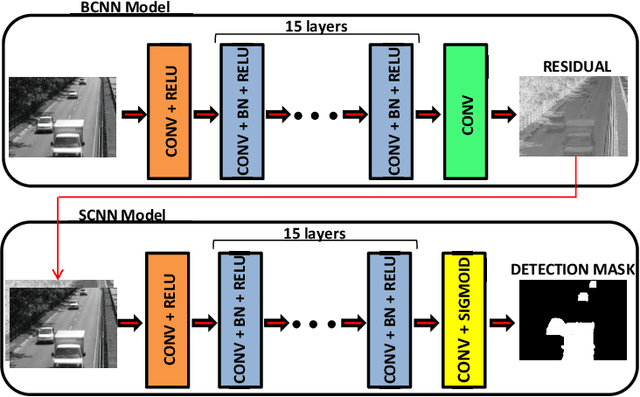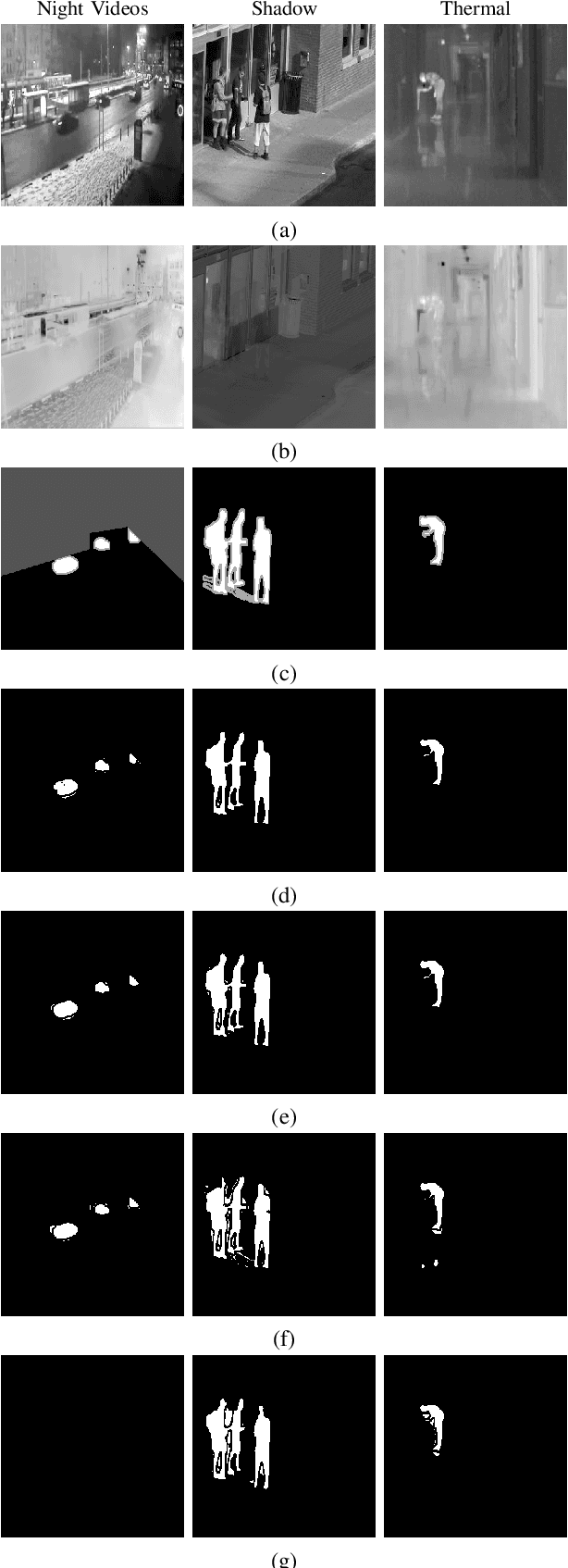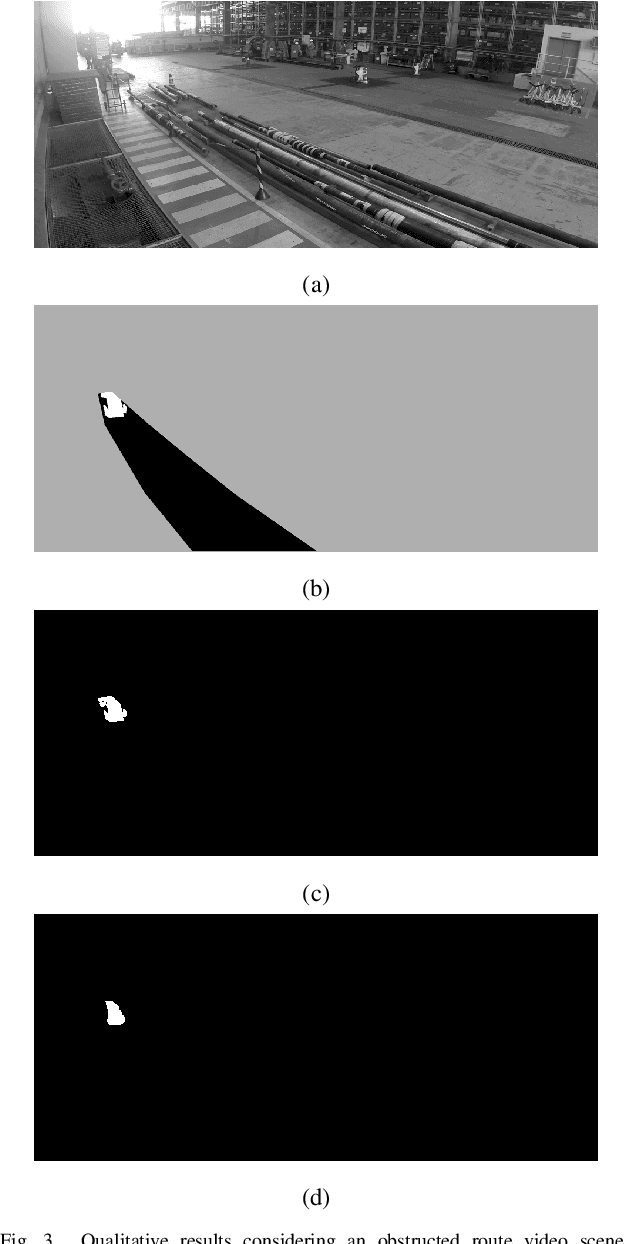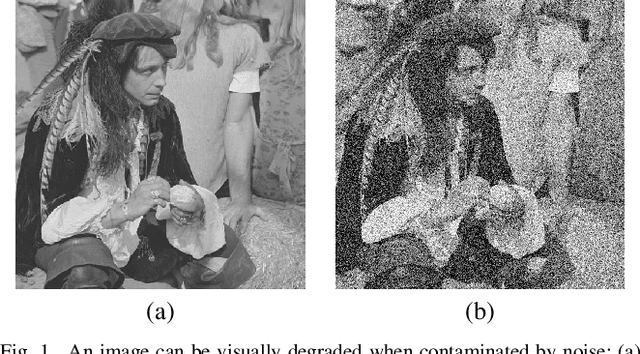Rafael G. Pires
Video Segmentation Learning Using Cascade Residual Convolutional Neural Network
Dec 20, 2022



Abstract:Video segmentation consists of a frame-by-frame selection process of meaningful areas related to foreground moving objects. Some applications include traffic monitoring, human tracking, action recognition, efficient video surveillance, and anomaly detection. In these applications, it is not rare to face challenges such as abrupt changes in weather conditions, illumination issues, shadows, subtle dynamic background motions, and also camouflage effects. In this work, we address such shortcomings by proposing a novel deep learning video segmentation approach that incorporates residual information into the foreground detection learning process. The main goal is to provide a method capable of generating an accurate foreground detection given a grayscale video. Experiments conducted on the Change Detection 2014 and on the private dataset PetrobrasROUTES from Petrobras support the effectiveness of the proposed approach concerning some state-of-the-art video segmentation techniques, with overall F-measures of $\mathbf{0.9535}$ and $\mathbf{0.9636}$ in the Change Detection 2014 and PetrobrasROUTES datasets, respectively. Such a result places the proposed technique amongst the top 3 state-of-the-art video segmentation methods, besides comprising approximately seven times less parameters than its top one counterpart.
Scene Change Detection Using Multiscale Cascade Residual Convolutional Neural Networks
Dec 20, 2022



Abstract:Scene change detection is an image processing problem related to partitioning pixels of a digital image into foreground and background regions. Mostly, visual knowledge-based computer intelligent systems, like traffic monitoring, video surveillance, and anomaly detection, need to use change detection techniques. Amongst the most prominent detection methods, there are the learning-based ones, which besides sharing similar training and testing protocols, differ from each other in terms of their architecture design strategies. Such architecture design directly impacts on the quality of the detection results, and also in the device resources capacity, like memory. In this work, we propose a novel Multiscale Cascade Residual Convolutional Neural Network that integrates multiscale processing strategy through a Residual Processing Module, with a Segmentation Convolutional Neural Network. Experiments conducted on two different datasets support the effectiveness of the proposed approach, achieving average overall $\boldsymbol{F\text{-}measure}$ results of $\boldsymbol{0.9622}$ and $\boldsymbol{0.9664}$ over Change Detection 2014 and PetrobrasROUTES datasets respectively, besides comprising approximately eight times fewer parameters. Such obtained results place the proposed technique amongst the top four state-of-the-art scene change detection methods.
DDIPNet and DDIPNet+: Discriminant Deep Image Prior Networks for Remote Sensing Image Classification
Dec 20, 2022Abstract:Research on remote sensing image classification significantly impacts essential human routine tasks such as urban planning and agriculture. Nowadays, the rapid advance in technology and the availability of many high-quality remote sensing images create a demand for reliable automation methods. The current paper proposes two novel deep learning-based architectures for image classification purposes, i.e., the Discriminant Deep Image Prior Network and the Discriminant Deep Image Prior Network+, which combine Deep Image Prior and Triplet Networks learning strategies. Experiments conducted over three well-known public remote sensing image datasets achieved state-of-the-art results, evidencing the effectiveness of using deep image priors for remote sensing image classification.
Image Denoising using Attention-Residual Convolutional Neural Networks
Jan 19, 2021



Abstract:During the image acquisition process, noise is usually added to the data mainly due to physical limitations of the acquisition sensor, and also regarding imprecisions during the data transmission and manipulation. In that sense, the resultant image needs to be processed to attenuate its noise without losing details. Non-learning-based strategies such as filter-based and noise prior modeling have been adopted to solve the image denoising problem. Nowadays, learning-based denoising techniques showed to be much more effective and flexible approaches, such as Residual Convolutional Neural Networks. Here, we propose a new learning-based non-blind denoising technique named Attention Residual Convolutional Neural Network (ARCNN), and its extension to blind denoising named Flexible Attention Residual Convolutional Neural Network (FARCNN). The proposed methods try to learn the underlying noise expectation using an Attention-Residual mechanism. Experiments on public datasets corrupted by different levels of Gaussian and Poisson noise support the effectiveness of the proposed approaches against some state-of-the-art image denoising methods. ARCNN achieved an overall average PSNR results of around 0.44dB and 0.96dB for Gaussian and Poisson denoising, respectively FARCNN presented very consistent results, even with slightly worsen performance compared to ARCNN.
 Add to Chrome
Add to Chrome Add to Firefox
Add to Firefox Add to Edge
Add to Edge